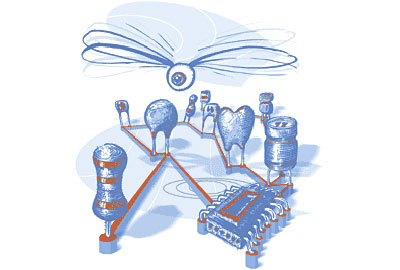Paessler IPCheck Server Monitor
Knowing what's happening on your network is always a challenge. Paessler wants to make your life easier with its IPCheck Server Monitor.

Despite issues with the multiple locations for management there is no doubt that there is a place for IPCheck in most datacentres. The main interface is simple and uncluttered and gives you the information you need in a screen that can be easily visually scanned.
One configuration option that you will want to think about is where to locate the probes to see if the sensors (services) are still working. By default, all the tests are run from the machine that you initially install IPCheck on. However, you can install remote probes on other machines around the network to reduce traffic and latency.
You might, for example, want to install a remote probe close to key users. If you have a service level agreement (SLA) this would enable you to keep an accurate watch on the service that they receive. Trying to run it across the network or even across multiple sites using the WAN can give misleading or pointless information. Paessler have clearly thought about this and remote probes are a must.
Once you get past the initial configuration and get to grips with which tool you need to manage this is a pleasing product to use for the IT manager.
I particularly liked the initial probe on the network, especially as it looks for SMTP and FTP services that are available. It is not unknown for malware to install its own SMTP or FTP service on a compromised machine. If you get nothing else out of IPCheck, you will be able to ensure that there are no unexpected surprises installed on your network.
The list of other sensors that IPCheck can use is good but if you want to use it to manage a wide range of application servers, there needs to be more standard services available by default. At present, Paessler expects you to add more sensors to track what is happening. This puts of lot of expectation of knowledge onto administrators.
What was disappointing is that when I wanted to add users, I couldn't do so by using any directory service catalogue. Tools that expect me to create their own lists of users and then maintain them separately from my primary directory service are a real pain. Most vendors are moving their products across to support the main directory services and Paessler needs to follow suite.
Another real benefit was allowing alerts to be sent to email, SMS or ICQ. However, unnecessarily, the setup for this was in the Windows Control Panel rather than the main program itself. Having to go to different places to turn them on and then configure them doesn't make sense. This was a general problem with the tool, as it creates extra work and unless you are fully familiar with what each tool allows you to configure, you waste time going to the wrong place.
Conclusion
One gets the impression that Paessler is in the processes of merging two products and hasn't quite finished, a situation it needs to sort out. If Paessler can do this, and remove the confusion over sensor, server and service this would be a really help hone what is a good product.
Verdict
Despite issues with the multiple locations for management there is no doubt that there is a place for IPCheck in most datacentres. The main interface is simple and uncluttered and gives you the information you need in a screen that can be easily visually scanned.
Supported OS: Windows 2000, XP, 2003, Vista or NT with SP6 (Workstation and Server supported), RAM: 256MB more Processor: Pentium III or higher Disk space: 40MB Recommended software: Internet Explorer 6 on Windows or Firefox 1.x or higher on Windows or any operating system For the Windows GUI: Windows 98, ME, NT4, XP, 2000, 2003, Vista with Internet Explorer 6.0 or higher
Get the ITPro daily newsletter
Sign up today and you will receive a free copy of our Future Focus 2025 report - the leading guidance on AI, cybersecurity and other IT challenges as per 700+ senior executives
-
 Cleo attack victim list grows as Hertz confirms customer data stolen – and security experts say it won't be the last
Cleo attack victim list grows as Hertz confirms customer data stolen – and security experts say it won't be the lastNews Hertz has confirmed it suffered a data breach as a result of the Cleo zero-day vulnerability in late 2024, with the car rental giant warning that customer data was stolen.
By Ross Kelly Published
-
 Women show more team spirit when it comes to cybersecurity, yet they're still missing out on opportunities
Women show more team spirit when it comes to cybersecurity, yet they're still missing out on opportunitiesNews While they're more likely to believe that responsibility should be shared, women are less likely to get the necessary training
By Emma Woollacott Published
-
 OpenAI wants developers using its new GPT-4.1 models – but how do they compare to Claude and Gemini on coding tasks?
OpenAI wants developers using its new GPT-4.1 models – but how do they compare to Claude and Gemini on coding tasks?News OpenAI says its GPT-4.1 model family offers sizable improvements for coding, but tests show competitors still outperform it in key areas.
By Ross Kelly Published